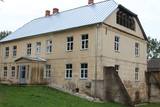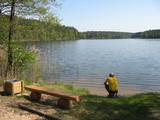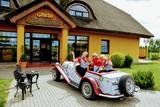| Нo | Название | Описание |
|---|---|---|
|
Парк усадьбы Йонишкелис, заложенный во второй половине XVIII в., отличается ландшафтной планировкой. В начале XIX в. парк был переоборудован и расширен. Через парк протекает река Мажупе. От усадьбы в сторону поселка ведет пешеходная липовая аллея. Напротив дворца разбита большая площадь. В парке растет более 20 пород местных деревьев и кустарников и более 30 пород интродуцированных растений. Внимания заслуживают две впечатляющие и ценные ели, своеобразная ель гнездовой формы, группа довольно редких для Литвы западных золотистых туй, дуб обыкновенный разнолистный, двуствольный серебристый клен, серый орех. Также в парке находятся три пруда. |
||
|
The origins of the castle that was built in the style of Classicism date back to 1784. Later it was rebuilt into a two-story building with a portico with four columns at its centre. A new period in the development of the state began in 1993, when restoration of the buildings began. The estate currently houses a children’s village, while the mansion is now a hotel.
|
||
|
The Forest Trail leads through smaller paths, arching around Vangaži Lutheran Church and the Werewolf Pine. On its way to the Hunting Palace, it passes the garden created by opera singer Anna Ludiņa and then follows the Hunting trail. The first side ravines with the pronounced relief of the ancient valley of the River Gauja can be seen here. One of them is located by Inčukalns Velnala (Devil’s Cave), surrounded by small river channels of the old Gauja. From there, the Forest Trail continues through meadows and crosses the Murjāņi–Valmiera motorway, where the recreation park “Rāmkalni” is located. In this park, there is a café, shop and active leisure centre with a sledge track. On this route you will mainly see pine forests of various ages, as well as the botanical plantation with 80 tree and 120 shrub species. By the end of the section, the landscape features sandstone outcrops – Devonian sedimentary rocks and habitats protected in Latvia. |
||
|
The key treasure in this park is that it has a lake that is one of the most intensive sites for birdwatchers in all of Latvia. It also features outstanding flora and the shallow waters of the Bay of Rīga. Recommended: Hike along the seashore from Mērsrags to Engure (20 km). See wild domestic animals (horses and cows) on the eastern shore of Lake Engure. There’s a bird-watching tower on the NW shore of the lake (approach from Kūļciems, where you can see domestic animals adapted to life in the wild, including the Blue Cows of Latvia). A bird-watching tower can be found at a place called Jomiņa near Mērsrags, where the seashore meadow is an uncommon biotope
|
||
|
С XV века в Приекуле правил род баронов Корфов. Один из них – Иоганн Альберт Корф (1697 - 1766.) был президентом Петербургской Академии наук (1734 - 1740 гг.), дипломатом и литератором, который занимался исследованием истории Курземе. Приекульский замок находится на западе от улицы Айзпуте, на берегу реки Вирга. Первоначально дворец господской усадьбы построили в XVIII веке, а в конце XIX века велись большие работы по перестройке здания (проект Пауля Макса Берчи). В здании находится Приекульская средняя школа. Примерно в 100 м к востоку от господской усадьбы возвышается смотровая башня усадьбы (построена в конце XIX века), над которой развевается государственный флаг Латвии. |
||
|
Muižas dzīvojamā ēka līdz mūsdienām nav saglabājusies. Šodien Dvietes muižas parkā ir apskatāmas muižas pārvaldnieka māja un trīs mūra saimniecības ēkas. 19. gs. veidots ainavu parks ar laukakmeņu mūrējuma tiltu. Parkā atrodas Dvietes muižas ēkas. |
||
|
Die zweitgrößte Insel Estlands mit breiter Waldung, Sand- und Steinstränden und einem der ältesten Leuchttürme Europas. |
||
|
This recently built 26-metre wooden tower is on Ūdri Hill (58 metres above sea level). It is on the north-eastern shore of Lake Usma, less than one kilometre from the lake. The tower offers an excellent view of Lake Usma, its islands, and the vast forests which surround it.
|
||
|
The aim of this territory is to regulate the natural and cultural landscapes of the upper reaches of the Daugava River valley, where there is a great deal of biological diversity. Nature trails have been installed in the park, as have bicycle routes. The river is good for boating in this area, too. The Curves of the Daugava nature park is part of the territory (see “Nature Parks”). |
||
|
Местность, где расположена усадьба, местными называется Центром деревни Домантай. Усадьба состоит из 4-ёх отдельных зданий, сохранивших традиции этнической архитектуры: карчама, житница, баня, традиционная изба. |
||
|
Исторический центр города. На этом месте 12 февраля 1670 года Курземский герцог Екаб провозгласил факт основания города. В начале 20 столетия на площади старого города, на булыжной мостовой размещался городской рынок. Теперь на периферии площади находится Народный дом, церковь Униатов и информационный центр туризма. На площади стоит осмотреть водяной насос, огромные весы и скульптуру рыси (символ Екабпилса). Отсюда можно отправиться на прогулку по историческому центру Екабпилса с узкими улочками и малоэтажной городской застройкой. |
||
|
Work on the arboretum, which covers 15 hectares of land, began in 1968, and it was meant to be a landscape park. The first plants were planted in 1972. During the fierce winter of 1976, sadly, many of the plants froze. In 1987, the park was redesigned. At that time it had 234 types of deciduous trees, coniferous trees and bushes. There are signs showing the Latin and Latvian names of the various plants
|
||
|
Данный маршрут предлагает осмотреть прекрасные сады в Латвии и Литве. В мемориальном саду Эдварда Вирзы можно увидеть деревья, которым посвящены стихи. Э. Вирза был латышским поэтом и писателем, написавшим роман «Страумени» о жизни латышских крестьян. В Струбергском декоративном саду предлагают экскурсию и консультации по садоводству. В усадьбе Брукнас вы сможете осмотреть сад, который был построен как парк эпохи Возрождения, розарий и виноградник. Красивая усадьба 18-го века Мазмежотне была восстановлена семьей зернопроизводителей. Рундальский дворец известен как жемчужина Латышского барокко и рококо, где можно посетить розарий и увидеть с более чем 2200 сортов роз. В поместье Бланкенфельде вы сможете увидеть уникальную коллекцию колоколов и насладитесь натуральными соками, сиропами и соленьями, приготовленными на месте. Посетив Домик перечной мяты, вы сможете насладиться мятным чаем, печеньем, медом с мятой и мятным сиропом. Следующая остановка – фермерское хозяйство «Дроши веселс», где выращивают овощи и производят лекарственные мази. В Литве вы можете посетить Жагаре (Žagari), известный своим вишневым садом - парком и особенным сортом вишни – «Жагарвишне» ("Žagarvyšnė"), включенным в национальный список сортов растений. Посетите приусадебный парк в Жагаре, в котором произрастают более 100 видов деревьев и кустарников. Вернувшись в Латвию, вы можете устроить пикник в дендрарии «Вилки», в котором растут около 1000 различных растений - как типичных для Латвийского пейзажа, так и уникальных. В питомнике по выращиванию саженцев в Залениеки вы можете прогуляться по дендрарию, где увидите более 2000 деревьев и кустарников. Красотой пионов можно насладиться в коллекционном саду Андра Беркина, а поблизости, в Виестарде в Кроньауце вам предложат экскурсии в великолепном саду тюльпанов. Живописный сад семьи Клуга славится бегониями, в свою очередь в Добельском институте садоводства имеется коллекция из более чем 200 сортов сирени. Сад красивых и практичных идей может похвастаться своей коллекцией хвойных деревьев, а владельцы предлагают продегустировать порошки из пряных трав, сушеные ягоды и фрукты. «Чай гномов» - одно из самых больших хозяйств по выращиванию лекарственных трав в Латвии (выращивают эхинацею, ноготки, ромашку и др.). Наконец, посетите питомник по выращиванию саженцев деревьев «Лиепас», специализирующийся на выращивании фруктовых деревьев, ягодных кустарников и роз. |
||
|
Находится на 67 км шоссе Рига – Лиепая (A9). Любимое место путешественников для обеда. Латышская кухня: Щавелевый суп, маринованная селедка с творогом, «Деревенская трапеза» (картофель, яйцо, копчено мясо, маринованный огурец), свиные котлеты, бефстроганов по-курземски, тушеная кислая капуста с охотничьими колбасками, ячменная каша с мясом, крем из черного хлеба, хлебный суп с взбитыми сливкам. |
||
|
Suitsu tornis celts 1979. g. kā pirmais Matsalu rezervāta metāla tornis. To atjaunoja 1998. g. Torņa augstums ir 21 m, tādēļ no tā paveras izcila dabas un kultūrainava uz Kazari deltas niedrājiem un blakus esošo Suitsu upi (Suitsu jõgi), kuras krastā ir uzceltas vairākas zvejnieku laivu būdas. |
||
|
Находится в Пастари, примерно на расстоянии 2,5 км от дороги Прейли - Виляны, в самом высоком месте с красивейшим пейзажем на Латгальскую возвышенность. Ветряная мельница голландского типа (с вращающимся механизмом крыльев) построена в 1902 году. В 2012 году были восстановлены крылья ветряной мельницы. По предварительной договоренности мельницу можно осмотреть изнутри. |
||
|
В хозяйстве выращивается 6 различных сортов кустовой черники. Хозяйка проведет по полям, расскажет о выращивании кустовой черники, а также угостит и предложит приобрести ценные ягоды. Дети оценят знакомство с домашними животными – кроликами и козами. |
||
|
Organic farm "Mežvijas" is engaged in vegetable growing, fruit growing and beekeeping and their processing - dried vegetables, berries, fruits, spice mixtures, candies, juices, syrups. |
||
|
Маршрут подходит для активных туристов, интересующихся многообразием природной и культурной среды национального парка «Кемери». Национальный парк «Кемери» (основан в 1997 г.) создан, прежде всего, для защиты водноболотных угодий – мелководного побережья Рижского залива, заросших прибрежных озер, болот, влажных лесов (трясин и др.) и пойменных лугов, как значимых мест произростания многих растений (~ 25 % от видов растений, занесенных в Красную книгу Латвии) и обитания животных, особенно мест скопления гнездящихся и перелетных птиц. На территории парка находится один из крупнейших заболоченных массивов Латвии – Большое Кемерское болото. Заболоченные массивы являются значимым местом образования и выхода сероводородных вод, а также местонахождения лечебных грязей, используемых в медицине, которые в свое время послужили основанием для создания известного курорта «Кемери». Информация о маршруте от Latvijas Lauku forums |
||























